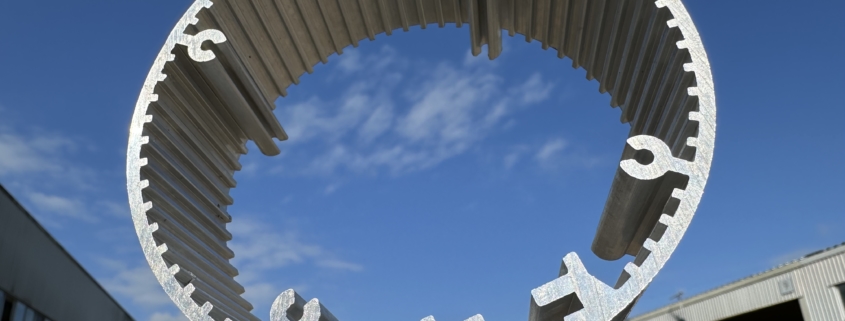Hot Topic: Aluminium & Thermal Conductivity
Hot Topic: Aluminium & Thermal Conductivity
Demand for aluminium is hotting up, so, with this in mind, we’re focusing our attention on the heat transfer and thermal conductivity of our favourite metal. Aluminium is highly effective as a conductor of heat, far better than steel and close to copper. So, is this an asset or an issue?
Benefits of Aluminium’s High Thermal Conductivity
Aluminium has strong heat transfer properties. These allow heat to be readily dissipated, distributed and exchanged, which are requirements in a wide range of applications. There are technical articles* detailing the exacting tensile strengths and density, but we’d like to share an overview of the heat transfer and thermal properties of aluminium.
Heat Dissipation
If you need to move heat away from a heat-generating source, aluminium’s thermal conductivity is an asset. Therefore, cast and extruded aluminium prevents overheating in applications including:
- Cylinder heads and pistons in combustion engines
- Battery packs in electric vehicles
- Heat sinks in electronic devices and components
- LED light fittings
By ensuring that heat is effectively dissipated, aluminium helps to prolong the lifespan of these devices.
Heat Transfer & Exchange
In other applications, the ability to heat up quickly and evenly distribute that heat is beneficial. This is why aluminium is a popular choice for car radiators, heating systems and saucepans. The fact that it’s also a non-toxic metal is another distinct advantage when it comes to kitchenware. In addition, aluminium is used for heat exchange in air conditioning units, geothermal and ground source heat pumps and vehicle engines.
Reflecting Heat
Aluminium’s shiny surface is great at reflecting heat. This has also proved to be effective even after oxidisation has dulled the outer surface. This reflective property can be used as a means of insulation. As such, sheet aluminium, often backed with foam, is used in underfloor heating, roof insulation, storage units and building panels.
How Resistant is Aluminium to Colder Temperatures?
Aluminium’s melting point is 660.3°c, so it can perform in many high-temperature environments, but what about at the other end of the spectrum? Fortunately, it is resistant to cold conditions and doesn’t become brittle like iron and steel. For this reason, aluminium extrusions are also used in cooling systems.
To prove how effective this metal is at resisting extreme temperatures and pressures, look up! You might be surprised to know that aluminium is the chosen building material for aircraft engineering, along with space shuttles** and equipment. We haven’t yet supplied aluminium extrusions for a Mars probe or satellite, but others in the industry have.
The Disadvantage of High Thermal Conductivity
High thermal conductivity has its advantages, yet, it isn’t a strong point when it comes to retaining heat. Yet, aluminium is widely used in construction so, how does this work?
Let’s consider the example of a window frame. In this application, the lightweight nature of aluminium is an asset, as is its corrosion resistance and sustainability. However, you need to retain warmth in the building to optimise energy efficiency. For these applications, a thermal barrier is positioned between internal and external aluminium extrusions. Made from a material with low conductivity, these minimise heat transfer.
An alternative option for reducing the thermal conductivity of aluminium, whilst retaining other beneficial qualities, is using an alloy. In many applications, a manganese or magnesium alloy would be recommended.
These options mean that the limitations of good thermal conductivity can be overcome if the benefits of aluminium make it worthwhile. So, let’s get back to the advantages!
The Thermal & Electrical Conductivity of Aluminium
Now, most thermal conductors are also good electrical conductors and aluminium is no exception. For this reason, aluminium is widely used on power cables in the electrical grid.
Aluminium extrusions are widely used as housing for cables, electrical connectors and bus bar systems. Bus bars are the common means of power distribution in industrial facilities, panelboards, and switch gears. They also collect and distribute electricity generated by wind turbines to the grid.
While we’re talking about renewable energy, aluminium extrusions are used as components in photovoltaic solar power systems.
Magnetism & Flammability
There are two further reasons why aluminium extrusions are a viable option for many of these applications. Firstly, it is considered paramagnetic, which translates as non-magnetic in most conditions. This means it offers electromagnetic screening, which is useful in bus bars, condensers and radio electronics.
Aluminium is also no-sparking, making it suitable for applications in flammable environments or involving explosive materials. So, whilst it excels at heat transfer and thermal conductivity, it isn’t going to start any fires.
The Properties of Aluminium Make it a Hot Topic!
It’s no secret that we think aluminium is a hot topic. Its efficiency in heat transfer and thermal conductivity coupled with non-magnetism, non-sparking and electrical conductivity make it ideal for many components, fixtures and fittings.
As aluminium extrusion specialists, we can advise on solutions for a wide range of industrial, automotive and commercial applications. With full in-house services, we’re happy to recommend suitable aluminium alloys, fabrication and finishes to achieve the results you require.
Just call us on 01296 431292 or email sales@salesmade.co.uk to start the conversation.
* https://www.ncbi.nlm.nih.gov/pmc/articles/PMC10144406/
** https://www.aluminum.org/nasa-takes-aluminum-final-frontier

